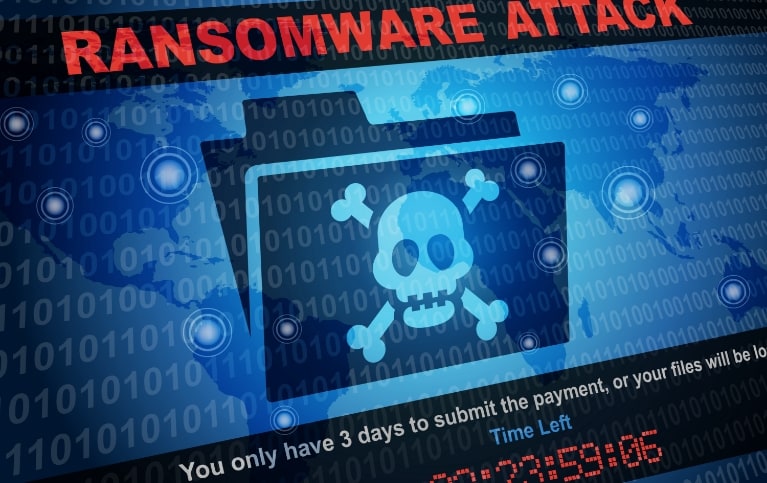Financially motivated cyberattacks are a dime a dozen, and one of the most popular that’s affecting US businesses today is ransomware. In fact, global reports revealed a 105% increase in ransomware attacks in 2021. While some ransomware attacks target individuals, many primarily target vulnerable organizations like healthcare institutions. Given the prevalence of ransomware attacks, your business should have a clear response strategy in case of such incidents. This guide discusses how you can do so.
What is ransomware, and how does it work?
Ransomware is a type of malware that encrypts a victim’s files, rendering them inaccessible unless a ransom is paid. The attacker will often demand payment in cryptocurrency like Bitcoin, and this amount will increase the longer the victim refuses to pay. In some cases, the attacker may threaten to release the victim’s data to the public if the ransom is not paid on time.
Once encrypted, the victim’s files can be difficult to recover without paying the ransom. Therefore, companies need to have a plan for how to deal with a ransomware attack before it happens.
Related reading: Find out how ransomware strains and behaviors have changed over the years
What are the signs of a ransomware attack?
Unlike many cyberthreats that operate in the background, ransomware often announces its presence once it infects your computer. The most common indicators of ransomware include:
- Unexplained system slowdowns or crashes
- Pop-up messages demanding payment in cryptocurrency
- Files or folders that have been encrypted and/or renamed
- Files and applications that cannot be opened
Should you pay the ransom?
Companies should never give in to hackers’ demands. While it may seem easier just to pay the ransom, there’s no guarantee that your files will be properly decrypted. They may actually leak the data they stole during the ransomware attack, even if you do pay. What’s more, paying the ransom encourages cybercriminals to double down on their ransomware efforts. If one of their ransomware attacks yielded profits, they may target your organization again or turn their attention to your clients and suppliers.
How can companies recover from a ransomware attack?
Companies can recover from ransomware attacks by doing the following:
Isolate the threat
The first thing you should do is try to isolate the threat and contain the damage. Disconnect any affected computers from your network immediately. Take any servers or storage devices offline if possible. This will prevent the ransomware from spreading further and encrypting more files while giving you more time to assess the situation.
Decrypt the files
Certain ransomware strains that have been extensively researched can be decrypted without having to pay the ransom. Cybersecurity vendors like Avast offer free ransomware decryption tools that will allow you to regain access to your data. Simply identify the ransomware that infected your systems and download the appropriate fix. The ransom note and file extension will usually give you a clue as to what ransomware strain you’re dealing with and which decryptor tool you should use.
Use anti-malware software
Anti-malware programs scan your systems for any traces of known ransomware strains in circulation. If they’re up to date with the latest threat intelligence databases, you may be able to detect and remove the ransomware from your systems. Keep in mind that while anti-malware programs are not able to decrypt your files, they can prevent the infection from spreading to other devices on your network.
Reformat and reinstall
In some cases, the only way to ensure that ransomware is gone is to reformat your hard drives and reinstall your operating system and applications. This will delete all of your files, so make sure you have data backups available.
Restore data from backups
You can easily recover from a ransomware attack and avoid having to pay the ransom if you have updated data backups from which you can restore clean versions of your files. Ideally, you should store your backups off site and offline so they cannot be affected by the ransomware strain currently plaguing your systems.
Report to the authorities
Report ransomware attacks to local FBI field offices and the Internet Crime Complaint Center. Doing so may help authorities track down the hackers responsible and protect other businesses from being targeted. The authorities may also connect you to experts who can resolve your ransomware problem.
Notify affected parties
After you’ve contained the damage and recovered your data, you should notify any affected parties via email or a public announcement on your website. This includes any customers, suppliers, or partners that may have been impacted by the ransomware attack. By warning people early, they can take preemptive measures to secure their networks, devices, and data. It also limits potential reputational damage to your company.
Contact cybersecurity specialists
Cybersecurity specialists like Dynamic Solutions Group can provide holistic solutions to your ransomware problems. We don’t just help with ransomware decryption and data recovery, but we can also protect your business from future threats.
What can companies do to defend against similar threats in the future?
When it comes to ransomware, prevention is better than cure. While you should have a ransomware response plan, you should also do the following to prevent such attacks from happening in the first place:
- Keep software up to date and patched.
- Use strong anti-malware and antivirus software.
- Train employees on cybersecurity best practices.
- BackupBack up data regularly.
- Restrict access to sensitive data.
- Monitor the network for suspicious activity.
Related reading: Learn more about how to protect your business from ransomware
Ransomware is a serious threat to businesses and can have a devastating impact. If you have been the victim of a ransomware attack or simply want to take precautionary measures, Dynamic Solutions Group is here to help. Call us today to create a ransomware plan and defense strategy.






